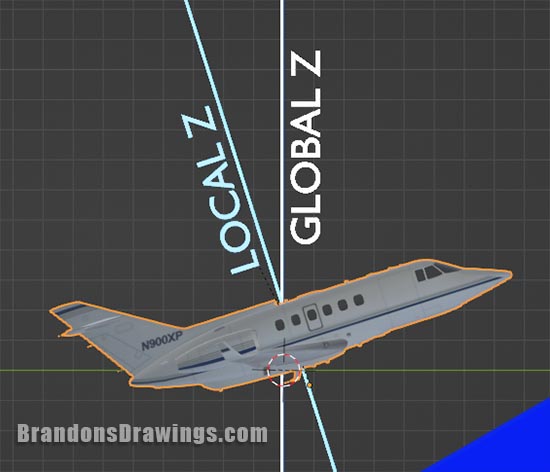When using Blender, you’ll come across the terms “Global Axis” and “Local Axis.” This Blender tutorial will help us understand the difference between a global axis and local axis.
Global Axis vs. Local Axis
In Blender, we are operating in 3D space and there are plenty of terms to be familiar with. Sometimes we will have to refer to either the “global axis” or the “local axis” and it’s important to know the difference.
Each “axis” set includes an X, Y and Z axis. Z is generally the “up and down” axis. But, the original reference points are different between the two.
You may also see “Global Space” and “Local Space” in Blender. The same concepts we cover will refer to how these terms relate. If we are operating in “local space” then we are referencing the original (local) X, Y and Z axes of the selected object.
Global Axis
The global axis is the X, Y or Z axis for the entire 3D scene. They do not change and serve as a single reference point for direction in your scene. No matter where you are in the scene, which object you have selected or what angle you are viewing from, the global axis or “Global Space” doesn’t change.
If we move any object up or down along the global Z axis (for example) it moves in the same direction.
Local Axis
The local axis is different. Each object has its own local axis. What is “up and down” for an object may be different from what is “up or down” for the 3D scene (the “global” axis).

If an individual object is rotated in Blender, its local axis adjusts with it. The global axis for the scene remains the same.
Global and Local Axis Example
The best example I can think of to understand a global axis and local axis is an airplane. Think of the global axis (X, Y and Z) as a compass of the world. North is always North. East is always East, etc.
But if you’re in the airplane, you can think of the local axis in terms of “Forward,” “Aft,” “Left” and “Right.”
When sitting in the cockpit of the plane, you’ll always have a left and right. But as the plane moves, the “Left and right” might change from the “East and West.”
You could even fly at an angle so that the “top” of the airplane is not straight up and down when compared to the world below (the “global Z axis” in this example).

Move and Rotate Along Local Axis Instead of Global
It’s actually a really good thing that Blender keeps track of each object’s “Local” axis orientation. It allows us to move and rotate along the local axis instead of the global when we need to.
Move Along Local Axis
When you press “G” to move in Blender, press the letter associated to the local axis you want to move along. Then, press that letter again. That’s right, pressing the “G + XX” will tell Blender to restrict movement along the local X axis.
Rotate Along Local Axis
To rotate along a local axis instead of a global axis, we press “R” to rotate and then press the letter (X,Y or Z) of the axis we want to rotate along twice. So, pressing “R + ZZ” will restrict the object’s rotation to the local Z axis.


